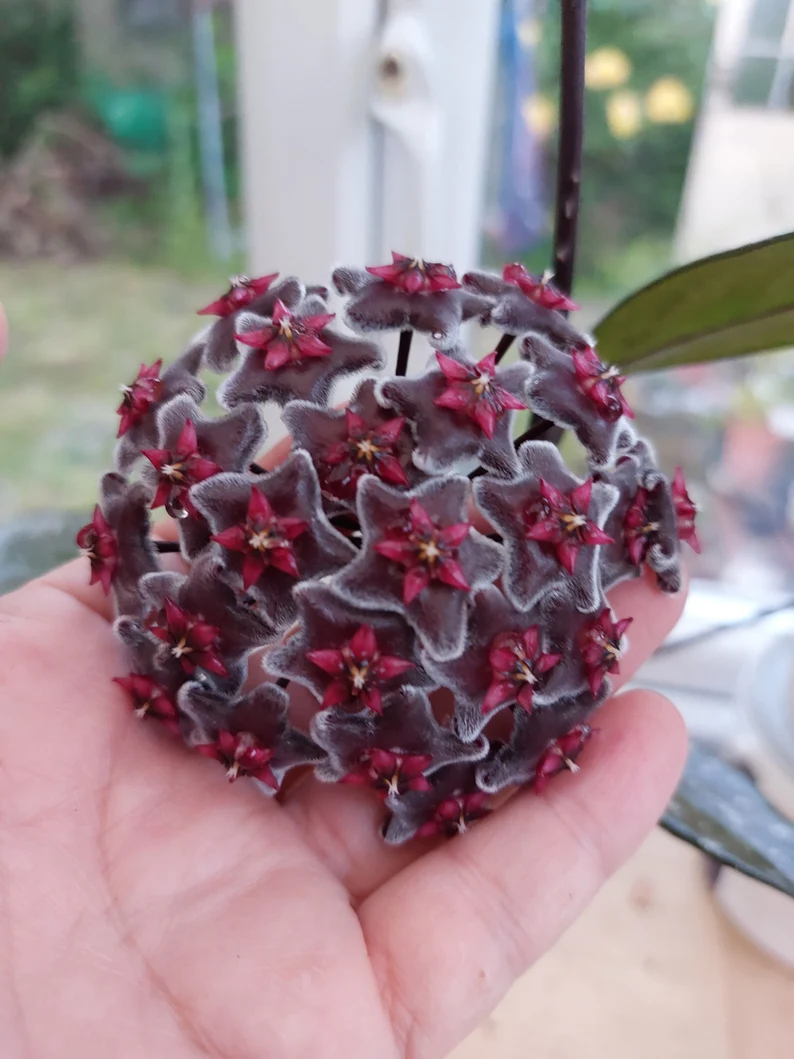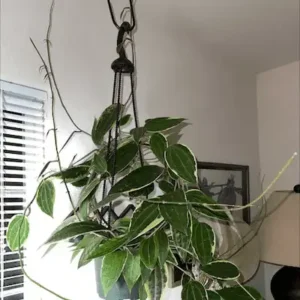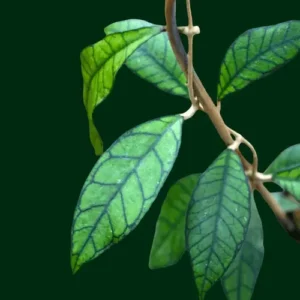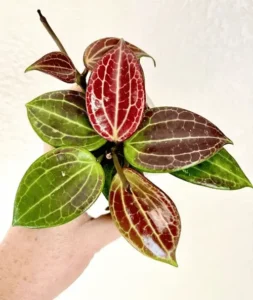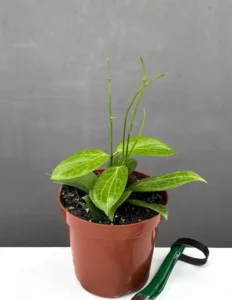Description
Hoya Pubicalyx ‘Royal Hawaiian Purple’ is one of the most popular among hoya pubicalyx hybrids due to its enduring ability and gorgeous waxy leaves that can be converted into deep purple clumps of flowers ( umbles). These waxy leaves have sweet-scented nectar. It is a trailing vine and an excellent choice for indoor spaces. It has many benefits, especially for those who are hoya (plant) lovers.
Properties
Scientific name: Hoya Pubicalyx ‘Royal Hawaiian Purple’ or Hoya Pubicalyx ssp
Common name: Wax flower, wax vine, porcelain flower, Hoya pubicalyx chimera.
Light requirements: Bright, indirect sunlight
Temperature requirements: 60°F and 85°F(16°C – 29°C)
Propagation: By stem cuttings
Facts
– Enduring capability
Hoya Pubicalyx ‘Royal Hawaiinn Purple’ is considered a resistant or durable houseplant due to its enduring capability. It thrives in low light.
– Choose a suitable pot
For a healthy and happy hoya plant, mimic its natural warm habitat and choose a suitable pot according to its size. Try to choose a pot that’s only 100 mm larger than its root ball for effective growth and has sufficient drain holes.
– Re-pot conditions
In general, hoyas like to be a bit pot-bound. They hate to be disturbed, so don’t disturb it. Only report it under suitable requirements.
Requirements for the better growth of Hoya Pubicalyx ‘Royal Hawaiinn Purple’
Here is a list of the requirements for the better growth of Hoya Pubicalyx ‘Royal Hawaiinn Purple’.
Soil requirements for Hoya Pubicalyx ‘Royal Hawaiinn Purple’
– Soil should be well-drained and well-aerated potting that is gently acidic, as hoya plants don’t like moist soil that leads to root rot which is the most prominent problem among hoyas. Root rot may result from the container holding too much water if the plant is not kept root-bound.
– Additionally, overwatering may prevent the plant from flowering. Between watering, allow the soil to dry out. Spring and summer seasons are the most effective seasons for growing the hoya plants. During these seasons, hoya plants require more watering as compared to the sleepy wintertime.
Care requirements for Hoya Pubicalyx ‘Royal Hawaiinn Purple’
Here are some care requirements for this beautiful porcelain flower as watering, light, temperature, and humidity-like conditions that you should follow.
Watering conditions for Hoya Pubicalyx ‘Royal Hawaiinn Purple’
Don’t overwater the hoya. In case of overwatering, there will be the risk of root rot which stops the growth of this durable houseplant.
Light conditions for Hoya Pubicalyx ‘Royal Hawaiinn Purple’
For effective growth provide bright, indirect sunlight with stable room temperatures of 60°F and 85°F (16°C – 29°C). Although, this hoya doesn’t like direct sunlight, put this wax vine in a place where no direct sunlight comes for effective growth.
Temperature and humidity conditions for Hoya Pubicalyx ‘Royal Hawaiinn Purple’
There should be stable room temperatures of 60°F and 85°F (16°C – 29°C) and humidity below 60 for enough growth of this wax flower.
Blooming and flowering tips
Here is a list of blooming and flowering tips for Hoya Pubicalyx ‘Royal Hawaiinn Purple’.
Importance of a fertilizer
During the growing season (spring and summer), feed your Hoya with a balanced, water-soluble fertilizer every 4-6 weeks. A fertilizer higher in phosphorus can help encourage blooming.
Importance of light and watering conditions
Provide bright, indirect sunlight and let the hoya dry between the waterings. Don’t overwater the hoya because hoyas like moist or well-drained soil, not wet soil.
Importance of temperature and humidity
Provide humidity below 60, not more than that, and stable room temperatures of 60°F and 85°F (16°C – 29°C) if you want to encourage this wax vine to bloom.
Problems with Hoya Pubicalyx ‘Royal Hawaiian Purple’
Yellow leaves issue with Hoya Pubicalyx ‘Royal Hawaiian Purple’
–Leaves turning yellow
-Leaves turning yellow due to overwatering and lack of light.
–Wilted, wrinkled leaves
-Wilted, wrinkled, or shriveled leaves are frequently signs of a serious water deficit. Water your plant adequately to ensure healthier development in the future.
Pests and insects issue with Hoya Pubicalyx ‘Royal Hawaiian Purple’
–Leaf spots, sooty mold and excess water on top leaves
-Yellowing, leaf spots, excess water on top leaves, sooty mold (develops on the leaves’ sugary, sappy leftovers), light and temperature angles, scale insects, pests and root rot which are the silent killers and occur when the soil is too moist.
–Sap-sucking insects
-Among the insects drawn to these species are whiteflies. Root rot and leaf drop can result from overwatering. These are all the common “sap-sucking” insects in the garden.
Root rot issue with Hoya Pubicalyx ‘Royal Hawaiian Purple’
Root rot is a common disease caused by overwatering and poor drainage.
Solutions to these problems
Here is a list of some solutions related to these problems.
-Use neem oil, check plants frequently, keep leaves clean, apply rubbing alcohol, steer clear of overwatering, and introduce natural predators to ward off aphids, mealybugs, and spider mites.
-Most “soft” insecticides and biological agents, which are easily accessible to home gardeners, can be used to control insects and pests.
-Leptomastix dactylopii and Anagyrus fusciventris are parasitic wasps that can be released into an affected area to suppress wilted leaves effectively.
Methods of propagation
Propagation by stem cuttings
Hoya Pubicalyx ‘Royal Hawaiian Purple’ is usually propagated by stem cuttings. Usually, hoya plants are propagated by stem cuttings in water or soil. For better propagation, take a healthy stem and cut below a leaf node with no defect.
Essential and optional aids
-On the other hand, some essential and optional aids can also enhance the propagation success rates, like, Using a popsicle-making container (fancy propagation equipment!) for the rooting because it holds the leaves up above the rim.
– Keep water in the container just above the bottom node and when the roots appear, make sure they’re covered too and remove all leaves, those at the top of shorter stem cuttings (no more than 1, 2, or 3 nodes) while rooting in a mixture.
FAQsIs Hoya pubicalyx royal hawaiian purple rare? The star-shaped glossy waxy leaves with gorgeous sweet-scented nectar are treated as rare purple. These blooms represent an olfactory delight. What is the difference between Hoya Red Button and Royal Hawaiian? Pubicalyx ‘Red Button’ has less speckling leaves as compared to Hoya pubicalyx ‘Royal Hawaiian’. That is the main difference between them. How do you care for Royal Hawaiian Hoya? Provide bright, indirect sunlight with stable room temperatures of 60°F and 85°F (16°C – 29°C) and semi-humid conditions. Does Hoya pubicalyx Royal Hawaiian Purple Flower smell? Yes, it smells like a sweet-scented nectar that adds an antique look and aroma to any indoor setting. |
Conclusion
In conclusion, Hoya Pubicalyx ‘Royal Hawaiian Purple’ is an enduring houseplant with gorgeous waxy leaves that can be converted into deep purple clumps of flowers ( umbles). It is a trailing vine and an excellent choice for indoor spaces. Under some suitable conditions, we can get a happy and healthy Hoya Pubicalyx ‘Royal Hawaiian Purple’.

